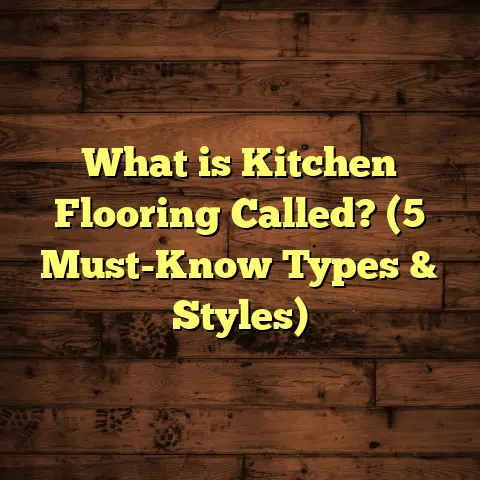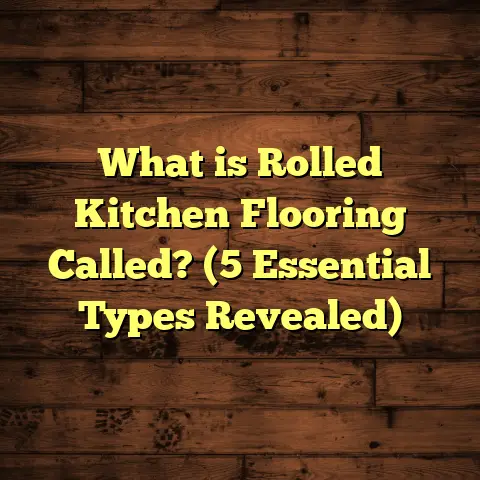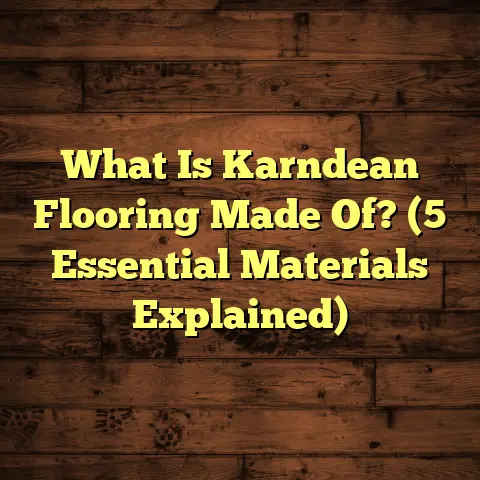What is the Cost to Stain Wood Floors per Sq Ft? (5 Key Factors)
Have you ever paused for a moment and thought about how much it would cost to stain your wood floors per square foot? Maybe you’re dreaming of transforming your living room or bedroom with a fresh coat of stain to bring out the wood’s natural beauty. Or perhaps you want to revive those tired-looking floors in your older home without breaking the bank. Staining wood floors is one of those projects that can dramatically change the feel of your space—but figuring out the cost is often confusing. I’ve spent years working on flooring projects, and I’ve helped homeowners like you understand what goes into pricing so they can make smart decisions. Let me take you through everything I’ve learned about this topic with stories, facts, and tips that’ll stick with you.
What Is the Cost to Stain Wood Floors per Sq Ft?
When I talk about the cost to stain wood floors per square foot, I’m referring to how much money you’ll spend to apply stain over a given area of hardwood or softwood flooring. This price usually includes labor, materials like stain and finish, and sometimes preparation work like sanding or repairs.
Staining is not just slapping on color. It’s a careful process where the wood surface is cleaned and prepared, the stain is applied evenly to bring out grain and tone, and then a protective finish seals it all in. The goal is to enhance the wood’s look while keeping it durable.
The price per square foot varies a lot depending on multiple factors like the type of wood, its condition, the stain used, labor costs in your area, and whether you want extra services like sealing or repairs. Over the years, I’ve seen prices from as low as $1 per sq ft for basic staining in small areas to $4 or more for complex jobs with premium materials.
To get a clear picture, let’s break down those key factors that influence how much you’ll pay.
Factor 1: Type and Condition of Your Wood Floors
Why Does Wood Type Matter?
Not all wood floors are created equal. The kind of wood you have can dramatically affect staining costs. Softer woods like pine or fir tend to absorb stain unevenly because their grain is looser. This can mean more coats or extra labor to get an even finish. On the other hand, hardwoods like oak, maple, or cherry usually take stain more uniformly but sometimes require more preparation.
I remember a project where a client had old pine floors that had faded over decades. We sanded them down and started staining, but because pine is so soft and porous, the stain soaked in patchily. We ended up applying three coats instead of two, which added almost 40% more labor time. That’s something you’ll want to keep in mind if your floors aren’t hardwood.
How Does Floor Condition Impact Cost?
The condition of your floors before staining is one of the biggest influencers on price. If your floors are in great shape—minimal scratches, no peeling finish—you might only need light sanding or buffing before staining. But for worn-out floors with deep scratches, gouges, or old multiple layers of finish, preparation becomes a bigger job.
On one occasion, I worked in a historic home where the floors were covered with layers of old varnish from different eras. We had to strip down four layers before getting to bare wood for staining. This prep work alone added hundreds of dollars to the estimate because it took days and special equipment.
If you’re doing this yourself or working with a contractor, don’t be surprised if prep work costs as much as staining itself in some cases.
Types of Wood Floors and Their Impact on Staining
| Wood Type | Absorption Rate | Typical Cost Impact |
|---|---|---|
| Pine (Softwood) | High | Higher staining cost due to multiple coats needed |
| Oak (Hardwood) | Moderate | Average cost; takes stain well |
| Maple (Hardwood) | Low | May require special stains; moderate cost |
| Cherry (Hardwood) | Moderate | Higher cost; rich appearance |
| Bamboo (Engineered) | Variable | May need specific stain types; varies by supplier |
Factor 2: Stain Quality and Color Choice
Different Types of Stain Materials
You might think stain is just stain, but there are big differences between oil-based, water-based, gel stains, and even penetrating stains.
- Oil-based stains: These are traditional and tend to penetrate deeply into wood grain. They dry slower but give rich tones. They are usually less expensive but take longer labor time.
- Water-based stains: These dry faster and have less odor, making them more eco-friendly. You get a wider range of colors and sheens but they cost more upfront.
- Gel stains: Thicker consistency that sits more on the surface; good for tricky woods but require careful application.
- Penetrating stains: Designed for deep absorption with minimal surface gloss; often used on rustic or distressed floors.
When I recommended a water-based stain to a client who wanted a bright, modern look with quick drying time, they were surprised by the higher price but loved how vibrant and even the color turned out.
How Does Color Affect Cost?
Light stains tend to be simpler because mistakes are easier to fix and fewer coats are needed. Dark stains—like espresso or ebony—require precision. You have to avoid streaks or blotchy patches which means longer application time and sometimes multiple coats.
Custom or mixed colors add complexity too. If you want a unique shade not readily available from suppliers, the cost will be higher due to mixing and testing.
Here’s a quick look at typical stain costs:
| Stain Type | Price Range (per gallon) | Typical Sq Ft Coverage | Approximate Cost per Sq Ft |
|---|---|---|---|
| Basic Oil-Based | $15 – $30 | 300 – 400 | $0.05 – $0.10 |
| Premium Oil-Based | $35 – $60 | 350 – 450 | $0.08 – $0.15 |
| Water-Based | $40 – $70 | 400 – 500 | $0.10 – $0.20 |
| Gel Stain | $50 – $80 | 300 – 400 | $0.12 – $0.20 |
The cost per square foot might seem low here because these prices are just for materials—but when you add labor, preparation, and sealing, it adds up.
Factor 3: Size of the Area and Complexity of Layout
Why Size Matters
Generally speaking, larger floor areas get better pricing per square foot because contractors can work more efficiently without moving equipment around so much.
For example, I once stained a large 1,200 sq ft open-plan floor for a family home at roughly $1.50 per sq ft total cost because we could set up our sanding machines and work systematically.
How Does Room Complexity Affect Cost?
On the flip side, rooms with lots of corners, built-in furniture, stairs, or intricate layouts slow down progress considerably.
I recall staining floors for a client whose living room had built-in shelves along all walls plus several pillars and a fireplace hearth. That job took twice as long as a simple rectangular room of equal size—and the price reflected that at close to $3 per sq ft.
Nooks and crannies require hand sanding instead of machine sanding—more labor hours—and careful brushwork instead of rollers for staining.
If you have complex layouts or multiple rooms connected by hallways with different flooring levels, expect costs on the higher side.
Impact of Multiple Rooms vs Open Floor Plans
Open floor plans are popular today because they make spaces feel larger—but they also help reduce staining costs since large continuous areas are easier to prep and finish.
Separate rooms require moving equipment repeatedly and more tape/covering materials between spaces. That adds time during prep and cleanup phases.
Factor 4: Labor Costs by Region and Contractor Experience
How Location Influences Price
Labor rates vary widely across regions in the US and worldwide due to local economies and demand for skilled tradespeople.
In metropolitan areas like New York City or San Francisco, I’ve seen staining labor charges as high as $3-$4 per sq ft just for applying stain (excluding materials). Meanwhile, smaller towns might average closer to $1.50-$2 per sq ft total.
Experience Matters
When I was starting out as a flooring contractor years ago, my rates were lower because I was building skills and reputation. Now with over a decade in this business, my pricing reflects efficiency without cutting corners.
Hiring someone with experience can save money overall because they complete jobs faster with fewer mistakes that cause rework.
How to Find Good Contractors Without Overpaying
I always encourage homeowners to get multiple quotes but beware of prices that seem too good to be true—they usually are.
Ask contractors questions about their process:
- How many coats do they apply?
- What type of prep work do they include?
- Do they guarantee their work?
A contractor who rushes or shortcuts prep will cost less upfront but may leave you with uneven color or short-lived finish.
Factor 5: Additional Services Like Sealing or Finishing
Why Sealing Is Non-Negotiable
Staining alone doesn’t protect your floor—it’s just color. To keep floors looking good year-round and resist scratches or water damage, sealing with polyurethane or similar finishes is essential.
Depending on your preference for gloss level (matte, satin, semi-gloss), costs vary slightly.
Types of Finish Options and Costs
- Oil-based polyurethane: Durable but longer dry time; has strong odor.
- Water-based polyurethane: Dries quickly; less odor; slightly less durable.
- Hardwax oils: Natural look; easy spot repair; usually more expensive.
- Wax finishes: Traditional but need frequent maintenance; less durable overall.
Finishing application typically adds $0.50-$1.50 per sq ft on top of staining costs.
Repairs Before Staining
If your floor has damaged boards or gaps, repairs may be required before staining. Replacing boards or filling cracks takes time and materials that increase total cost.
My Personal Story: A Journey Through Staining Floors
Let me share one memorable project that taught me a lot about how costs add up—and how important clear communication with clients is.
A couple bought an older bungalow with original oak floors covered in decades-old varnish layers. They wanted a dark cherry stain to modernize their living room (about 700 sq ft).
When we started sanding, we found deep scratches and some water damage near windows. The prep took two extra days than planned because we had to replace some boards and sand carefully around radiators.
We used a premium water-based stain with three coats for rich color plus three coats of satin polyurethane finish for durability.
The total came out around $3.25 per square foot—higher than their initial budget—which surprised them at first.
But after explaining each step and showing before-and-after photos during the process, they understood why it was worth it.
They told me months later their floors still looked great despite heavy use—and said they’d rather pay upfront than deal with problems later.
Detailed Data Points Backing Costs
I like data because it helps homeowners plan realistically. Here are some averages from national surveys and my own records:
- Average staining cost nationwide: $1.50 – $3.00 per sq ft
- Average sanding/prep adds: $0.50 – $1.50 per sq ft
- Sealing/finishing adds: $0.50 – $1.50 per sq ft
- Material costs (stain + finish): $0.75 – $1.25 per sq ft
- Total average project size: 500 – 1500 sq ft
- Time required: 3 – 7 days including curing
How To Use Online Tools Like FloorTally To Estimate Costs
One tool I recommend when budgeting is FloorTally—it’s an online platform where you enter your area size and select material types to get local cost estimates including labor.
It accounts for waste factors (extra material needed), regional labor rates, and lets you compare different stains or finishes side-by-side easily.
Using such tools before calling contractors can help you know if quotes are reasonable or if adjustments might fit your budget better.
Tips From My Experience To Get The Best Value
- Don’t rush preparation: Skipping sanding can save money initially but leads to blotchy stains.
- Choose colors thoughtfully: Darker shades require more skill—budget accordingly.
- Ask about warranty: Good contractors stand behind their work.
- Plan for sealing: It protects your investment longer.
- Get multiple quotes: Compare not just price but scope of work.
- Consider DIY if confident: Rent equipment but expect a learning curve.
- Schedule during off-season: Some contractors offer discounts in slower months.
- Check references: Past client reviews can save headaches later.
- Be clear about expectations: Share photos or samples with your contractor.
- Maintain your floors afterward: Regular cleaning prolongs life between refinishings.
Common Questions I Get Asked About Wood Floor Staining Costs
Q: Can I stain over old hardwood finish?
A: Usually no—you need bare wood for stain penetration unless using specialized gel stains designed for overlays.
Q: How long does staining last?
A: With proper sealing and care, 5-10 years before refinishing may be needed depending on wear.
Q: What if my floor has pet damage?
A: Repairs must come first—staining won’t hide gouges fully.
Q: Is DIY staining cheaper?
A: Yes upfront but risk uneven results unless you have experience.
Q: How soon can furniture go back on stained floors?
A: Usually after 24-48 hours curing; full hardness takes weeks.
Wrapping Up My Thoughts on Staining Costs
Staining wood floors per square foot isn’t just about buying stain—it’s about understanding the whole process from prep through finishing combined with local labor rates and material quality choices.
From my years working hands-on with clients across different homes and budgets, I know every project is unique but these five factors consistently drive cost:
- Wood type & condition
- Stain & color selection
- Floor size & complexity
- Labor & contractor expertise
- Additional finishing & repairs
If you’re thinking about staining your floors soon, take time to assess these areas carefully so you can get quotes that match your vision without surprises later on.
If you want me to help estimate your project specifically based on your floor details or suggest stain options tailored to your style—just ask!
Are you ready to make those wood floors stunning again?





